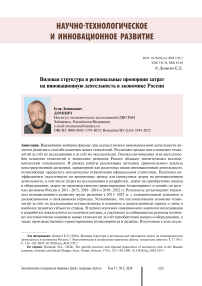The specific structure and regional proportions of innovation costs in the Russian economy
Автор: Domnich Ye.L.
Журнал: Economic and Social Changes: Facts, Trends, Forecast @volnc-esc-en
Рубрика: Science, technology and innovation development
Статья в выпуске: 5 т.17, 2024 года.
Бесплатный доступ
The most important choice of a company in the implementation of innovative activities is the decision on the method of mastering new technologies. There is a distinction, first of all, between the development of technologies through their research and through their operation. The assessment of the ratio of these two methods of technology development in the economy of Russian regions has significant research potential. The study implements a methodology for comparative analysis of the spatial dynamics of various types of innovation activities, which allows overcoming the methodological limitations of official statistics. The coefficients of elasticity according to the time trend for the total costs of innovation activities, including research and development costs, costs for the purchase of machinery and equipment, and costs for industrial design (engineering) and design by groups of regions of Russia in 2011-2015, 2016-2018 and 2019-2022 were obtained. The results of the study detail the trends in the innovative development of groups of regions in 2011-2022 with a specification of the dynamics in the pre-sanctions and sanctions periods. It has been established that the systematic development of technologies through their research was carried out mainly in the pre-sanctions period and only in the most developed regions. During the period of increasing sanctions pressure, research and development are localized in metropolitan centers, and remote and underdeveloped regions begin to systematically master new technologies through the purchase of machinery and equipment, as well as industrial design (engineering) and design. The system of econometric estimates obtained in the study, which takes into account both the economic specifics of innovations and the methodological problems of their statistical accounting, made it possible to specify
Innovations, research and development, purchase of machinery and equipment, engineering, regions of Russia, sanctions shock, official statistics
Короткий адрес: https://sciup.org/147245874
IDR: 147245874 | УДК: 330.34 | DOI: 10.15838/esc.2024.5.95.7
Список литературы The specific structure and regional proportions of innovation costs in the Russian economy
- Charyton C. (2015). Creative engineering design: The meaning of creativity and innovation in engineering. In: Charyton C. (Ed.) Creativity and Innovation among Science and Art. London: Springer. DOI: 10.1007/978-1-4471-6624-5_7
- Cho Y. (2020). The effects of knowledge assets and path dependence in innovations on firm value in the Korean semiconductor industry. Sustainability, 12(2319). DOI: 10.3390/su12062319.
- Clauss T., Kraus S., Kallinger F.L., Bican P.M., Brem A., Kailer N. (2020). Organizational ambidexterity and competitive advantage: The role of strategic agility in the exploration-exploitation paradox. Journal of Innovation & Knowledge, 6(4). DOI: 10.1016/j.jik.2020.07.003
- Dementiev V.E. (2024). On the ability of regions to adapt to various external shocks. Ekonomicheskie i sotsial'nye peremeny: fakty, tendentsii, prognoz=Economic and Social Changes: Facts, Trends, Forecast, 17(3), 36–49. DOI: 10.15838/ esc.2024.3.93.2 (in Russian).
- Domnich Ye.L. (2018). Regional and sectoral proportions of technological innovations in Russia’s industry. Regionalistica=Regionalistics, 5(1), 41–58. DOI: 10.14530/reg.2018.1.41 (in Russian).
- Domnich Ye.L. (2022). Innovation as a factor of changing the productivity of enterprises: Measurement and interpretation issues. Prostranstvennaya ekonomika=Spatial Economics, 4, 93–127. DOI: 10.14530/se.2022.4.093-127 (in Russian).
- Edwards-Schachter M. (2018). The nature and variety of innovation. International Journal of Innovation Studies, 2(2), 65–19. DOI: 10.1016/j.ijis.2018.08.004
- Gershman M., Thurner T.W., Chudaeva M. (2020). Industrial design for economic growth: Russia’s efforts to improve its manufacturing sector. Creative Industries Journal, 13(3), 244-258. DOI: 10.1080/17510694.2019.1707520
- Golova I.M. (2024). Coordination of regional innovation processes to ensure the technological competitiveness of Russia. Ekonomika regiona=Economy of regions, 20(1), 63–75. DOI: 10.17059/ekon.reg.2024-1-5 (in Russian).
- Huber P.J. (1967). The behavior of maximum likelihood estimates under nonstandard conditions. In: Proceedings of the Fifth Berkeley Symposium on Mathematical Statistics and Probability. Berkeley, CA: University of California Press.
- Johnson P.C., Laurell C., Ots M., Sandström C. (2022). Digital innovation and the effects of artificial intelligence on firms’ research and development – Automation or augmentation, exploration or exploitation? Technological Forecasting and Social Change, 179(121636). DOI: 10.1016/j.techfore.2022.121636.
- Lennerts S., Schulze A., Tomczak T. (2019). The asymmetric effects of exploitation and exploration on radical and incremental innovation performance: An uneven affair. European Management Journal, 38(1), 121–134. DOI: 10.1016/j.emj.2019.06.002
- Li P., Liu H., Li Y., Wang H. (2023). Exploration–exploitation duality with both tradeoff and synergy: The curvilinear interaction effects of learning modes on innovation types. Management and Organization Review, 19(3), 498–532. DOI: 10.1017/mor.2022.49
- Lukman A.F., Adewuyi E., Månsson K., Kibria B.S.G. (2021). A new estimator for the multicollinear Poisson regression model: Simulation and application. Scientific Reports, 11(3732). DOI: 10.1038/s41598-021-82582-w
- Mahmood T., Mubarik M.S. (2020). Balancing innovation and exploitation in the fourth industrial revolution: Role of intellectual capital and technology absorptive capacity. Technological Forecasting and Social Change, 160(1), 120248. DOI: 10.1016/j.techfore.2020.120248
- Medyanik Yu.V. (2017). Engineering services market in Russia: Problems and development prospects. Rossiiskoe predprinimatel'stvo=Russian Journal of Entrepreneurship, 18(24), 4221–4234. DOI: 10.18334/rp.18.24.38595 (in Russian).
- Schumpeter J. (1934). The Theory of Economic Development. Cambridge, MA: Harvard University Press.
- Shorokhova I.S. (2024). Methodological approach to assessing the impact of concentration effects on the innovative development of Russian regions. Problemy razvitiya territorii=Problems of Territory's Development, 28(1), 42–60. DOI: 10.15838/ptd.2024.1.129.4 (in Russian).
- Tereshchenko D.S. (2024). Interregional effects of innovations in Russia: Analysis from the Bayesian perspective. Prostranstvennaya ekonomika=Spatial Economics, 20(1), 125–143. DOI: 10.14530/se.2024.1.125-143 (in Russian).
- Wen J., Qualls W.J., Zeng D. (2020). To explore or exploit: The influence of inter-firm R&D network diversity and structural holes on innovation outcomes. Technovation, 100(3), 102178. DOI: 10.1016/j.technovation.2020.102178
- White H. (1980). A heteroskedasticity-consistent covariance matrix estimator and a direct test for heteroskedasticity. Econometrica, 48, 817–830. DOI: 10.2307/1912934


